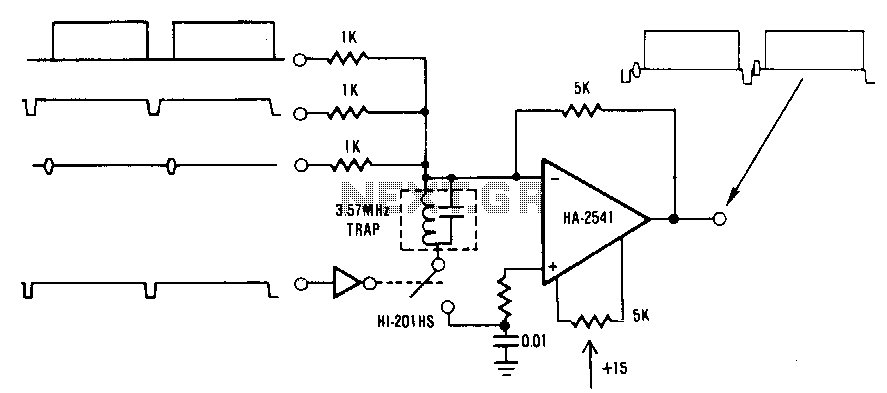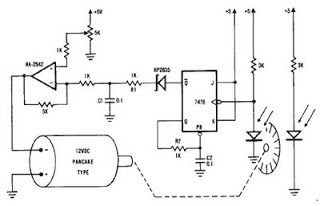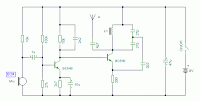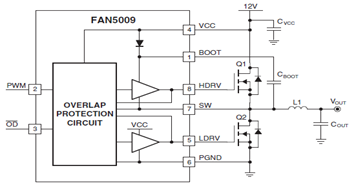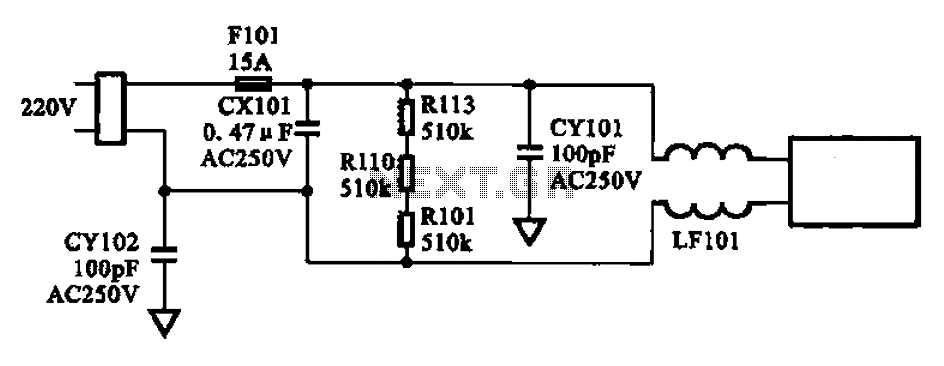
ic 555 motorcycle alarm circuit
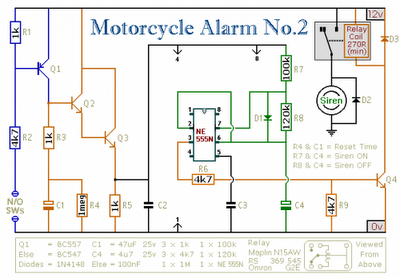
Any number of normally-open switches may be utilized. Install "tilt" switches that close when the steering is moved or when the bike is lifted off its side-stand or pushed forward off its centre-stand. Employ micro-switches to secure removable panels and the lids of panniers, among other components. The alarm's standby current is virtually zero, ensuring it will not drain the battery. Once activated, the frequency at which the siren switches on and off is regulated by resistors R7, R8, and capacitor C4. For instance, increasing R7 will extend the sound duration, while increasing R8 will prolong the silent intervals. The circuit is designed to operate an electronic siren consuming 300 to 400 mA. Utilizing the bike's own horn is generally discouraged due to its accessibility and potential for disconnection. However, if the horn is chosen, it is important to note that the alarm relay is not rated to handle the required current. Therefore, connect the coil of a suitably rated relay to the "Siren" output, which can then activate the horn, flash the lights, etc. The circuit board and switches must be shielded from environmental elements, as moisture or condensation can lead to malfunctions. A 1-amp in-line fuse should be installed as close as possible to the power source; this is crucial for protecting the wiring rather than the alarm itself. The specific installation process will vary depending on the make of the motorcycle, limiting the ability to provide further assistance or advice in this area.
The described circuit involves a security system for motorcycles, utilizing multiple normally-open switches to enhance functionality and safety. The inclusion of tilt switches is particularly advantageous, as they serve to activate the alarm under specific conditions, such as when the motorcycle is tilted or lifted, thus preventing unauthorized use. Micro-switches add another layer of security by safeguarding access to removable panels and storage compartments, ensuring that critical components remain protected.
The alarm system operates with an extremely low standby current, which is beneficial for battery longevity, making it suitable for motorcycles that may not be used frequently. The activation mechanism of the alarm is governed by the timing components R7, R8, and C4. This configuration allows for customization of the sound duration and silent intervals, enabling users to tailor the alarm's response to their preferences. The use of an electronic siren rated for 300 to 400 mA ensures that the alarm generates a noticeable sound without overwhelming the motorcycle's electrical system.
In cases where the motorcycle horn is considered for use with the alarm, it is essential to incorporate a relay capable of handling the horn's current requirements, as the alarm's relay alone is insufficient. This relay acts as an intermediary, allowing the alarm system to control high-current devices such as the horn or lights without risking damage to the alarm circuitry.
Environmental protection is a critical aspect of the circuit design. The circuit board and switches must be adequately shielded to prevent damage from moisture and condensation, which could compromise the system's functionality. The installation of a 1-amp in-line fuse near the power source is a vital safety measure, designed to protect the wiring from potential overloads. The specific wiring and installation process will depend on the motorcycle model, which necessitates careful consideration during setup to ensure optimal performance and reliability of the alarm system.Any number of normally-open switches may be used. Fit "tilt" switches that close when the steering is moved or when the bike is lifted off its side-stand or pushed forward off its centre-stand. Use micro-switches to protect removable panels and the lids of panniers etc. The alarm`s standby current is virtually zero - so it won`t drain your battery . Once activated - the rate at which the siren switches on and off is controlled by R7, R8 & C4. For example, increasing R7 will make the sound period longer - while increasing R8 gives longer silent periods. The circuit is designed to use an electronic Siren drawing 300 to 400mA. It`s not usually a good idea to use the bike`s own Horn because it can be easily located and disconnected.
However - if you choose to use the Horn - remember that the alarm relay is too small to carry the necessary current. Connect the coil of a suitably rated relay to the "Siren" output. This can then be used to sound the Horn, flash the lights etc. The circuit board and switches must be protected from the elements. Dampness or condensation will cause malfunction. Connect a 1-amp in-line fuse AS CLOSE AS POSSIBLE to your power source. This is VERY IMPORTANT. The fuse is there to protect the wiring - not the alarm. Exactly how the system is fitted will depend on the make of your particular machine - so I`m unable to provide any further help or advice in this regard.
🔗 External reference
The described circuit involves a security system for motorcycles, utilizing multiple normally-open switches to enhance functionality and safety. The inclusion of tilt switches is particularly advantageous, as they serve to activate the alarm under specific conditions, such as when the motorcycle is tilted or lifted, thus preventing unauthorized use. Micro-switches add another layer of security by safeguarding access to removable panels and storage compartments, ensuring that critical components remain protected.
The alarm system operates with an extremely low standby current, which is beneficial for battery longevity, making it suitable for motorcycles that may not be used frequently. The activation mechanism of the alarm is governed by the timing components R7, R8, and C4. This configuration allows for customization of the sound duration and silent intervals, enabling users to tailor the alarm's response to their preferences. The use of an electronic siren rated for 300 to 400 mA ensures that the alarm generates a noticeable sound without overwhelming the motorcycle's electrical system.
In cases where the motorcycle horn is considered for use with the alarm, it is essential to incorporate a relay capable of handling the horn's current requirements, as the alarm's relay alone is insufficient. This relay acts as an intermediary, allowing the alarm system to control high-current devices such as the horn or lights without risking damage to the alarm circuitry.
Environmental protection is a critical aspect of the circuit design. The circuit board and switches must be adequately shielded to prevent damage from moisture and condensation, which could compromise the system's functionality. The installation of a 1-amp in-line fuse near the power source is a vital safety measure, designed to protect the wiring from potential overloads. The specific wiring and installation process will depend on the motorcycle model, which necessitates careful consideration during setup to ensure optimal performance and reliability of the alarm system.Any number of normally-open switches may be used. Fit "tilt" switches that close when the steering is moved or when the bike is lifted off its side-stand or pushed forward off its centre-stand. Use micro-switches to protect removable panels and the lids of panniers etc. The alarm`s standby current is virtually zero - so it won`t drain your battery . Once activated - the rate at which the siren switches on and off is controlled by R7, R8 & C4. For example, increasing R7 will make the sound period longer - while increasing R8 gives longer silent periods. The circuit is designed to use an electronic Siren drawing 300 to 400mA. It`s not usually a good idea to use the bike`s own Horn because it can be easily located and disconnected.
However - if you choose to use the Horn - remember that the alarm relay is too small to carry the necessary current. Connect the coil of a suitably rated relay to the "Siren" output. This can then be used to sound the Horn, flash the lights etc. The circuit board and switches must be protected from the elements. Dampness or condensation will cause malfunction. Connect a 1-amp in-line fuse AS CLOSE AS POSSIBLE to your power source. This is VERY IMPORTANT. The fuse is there to protect the wiring - not the alarm. Exactly how the system is fitted will depend on the make of your particular machine - so I`m unable to provide any further help or advice in this regard.
🔗 External reference

